Estimated reading time 19 minutes, 18 seconds.
The rise and fall of Bombardier as the world’s third-largest commercial aircraft manufacturer is an important roller-coaster of a story that is still reverberating throughout Canada’s aerospace industry.
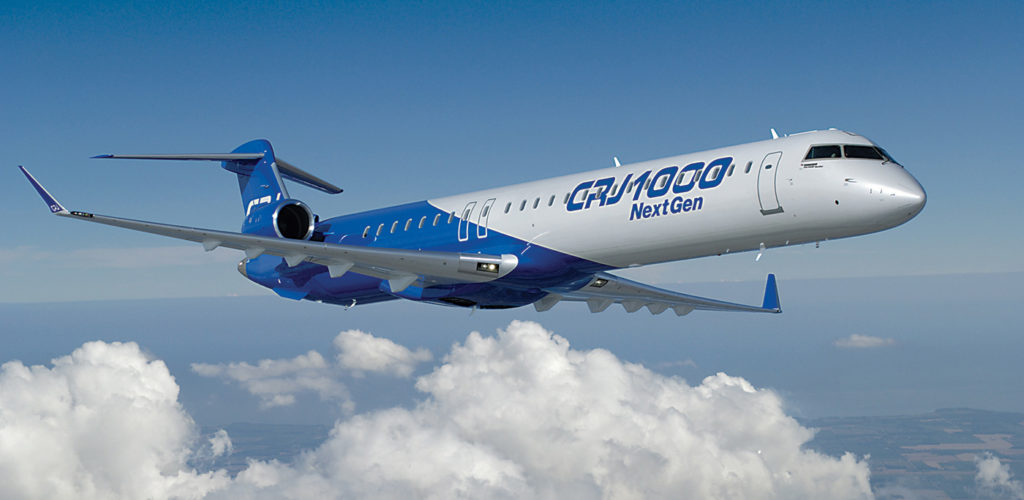
Pinnacles during the erratic ride included first flights of eight new commercial aircraft models between 1991 and 2015, multi-billion-dollar aircraft exports, high production rates, good profits, and the flawless entry into service of the new generation C Series passenger jet.
The low points included the loss of market share to competitors, production drops, financial losses, and the $6 billion price tag to develop the C Series – which almost killed Bombardier as a company.
On the 33-year journey, the commercial aircraft business provided thousands of good paying jobs and the CRJ (Canadair Regional Jet) became one of the top selling commercial jets of all time.
But this roller-coaster ride of an aviation story has now come to an end. (The author foresaw such a scenario in “Regional Tipping Point?” published in Skies about 20 months ago.)
Bombardier Commercial Aircraft has been broken up, with Airbus buying the C Series program in June 2018, Longview Aviation Capital Corp. buying the Q400 Dash 8 program in June 2019, and Mitsubishi Heavy Industries buying the CRJ program in a deal expected to close by mid-2020.
This represents a major restructuring of the Canadian aerospace industry that will impact thousands of highly skilled aerospace workers across Canada and the world.
Here is an in-depth look at the commercial aircraft programs now moving to new owners.

Bombardier diversifies
Bombardier produced its first commercial snowmobile in 1937, introduced the Ski-Doo in 1959 and expanded into the mass transit business in 1974.
The Liberal government of Pierre Trudeau acquired de Havilland Aircraft of Canada Limited (DHC) from Hawker Siddeley in 1974 and Canadair from General Dynamics in 1976, funding the development of the Dash 7, Dash 8 and Canadair Challenger.
In 1986, the new Conservative government of Brian Mulroney decided to exit the aircraft manufacturing business by selling Canadair to Bombardier and de Havilland Canada to Boeing.
In 1989, Bombardier acquired Short Brothers from the U.K. government and then, in 1990, Learjet. Finally, it acquired DHC from Boeing in 1992.
This series of purchases gave Bombardier a strong portfolio of business aircraft (Challengers and Learjets), regional aircraft (Dash 8s and Shorts 330/360), aerial firefighters (CL-215), military trainers (Shorts Tucano) and transports (Shorts C-23 Sherpa) – all of which needed to be renewed.
Bombardier president Laurent Beaudoin hired executives with aviation and/or government experience to lead the aerospace business and secure government support for new aircraft programs.
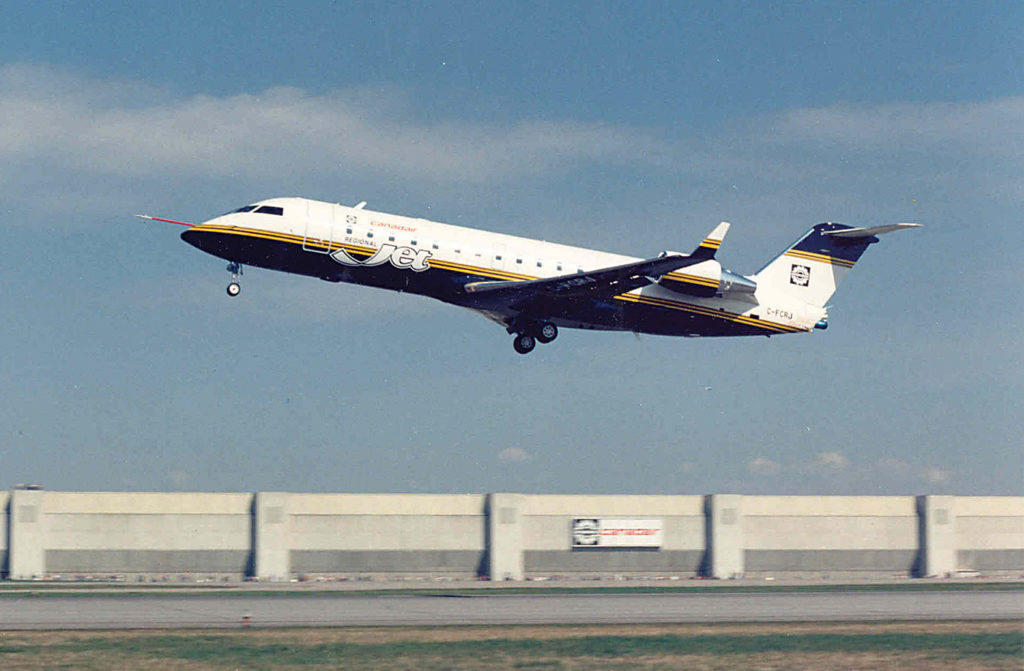
Canadair Regional Jet
The first new aircraft conceived under Bombardier ownership was the 50-seat Canadair Regional Jet (CRJ).
The CRJ capitalized on the increased competition between major airlines at the feeder level, the range limitations of turboprops, a public preference for turbofan aircraft, and the lower cost of developing an airliner based on an existing business jet (CL-600 type certificate), rather than investing hundreds of millions of dollars in a clean sheet aircraft design.
The Canadair Regional Jet Series 100 aircraft was launched on March 31, 1989, with orders for 56 aircraft and six options. One of those original customers was DLT of Cologne, Germany, which in March 1992 was renamed Lufthansa CityLine, becoming a wholly owned subsidiary of Lufthansa in 1993.
The prototype CRJ was rolled out with great fanfare at Montreal’s Dorval Airport on May 6, 1991, before 1,800 employees, guests, politicians, customers and media (including the author). It flew for the first time four days later on May 10, 1991.
Bombardier buys de Havilland Canada
In January 1992, employees at DHC rejoiced when Bombardier and the Ontario government jointly bought the company for $100 million from The Boeing Company.
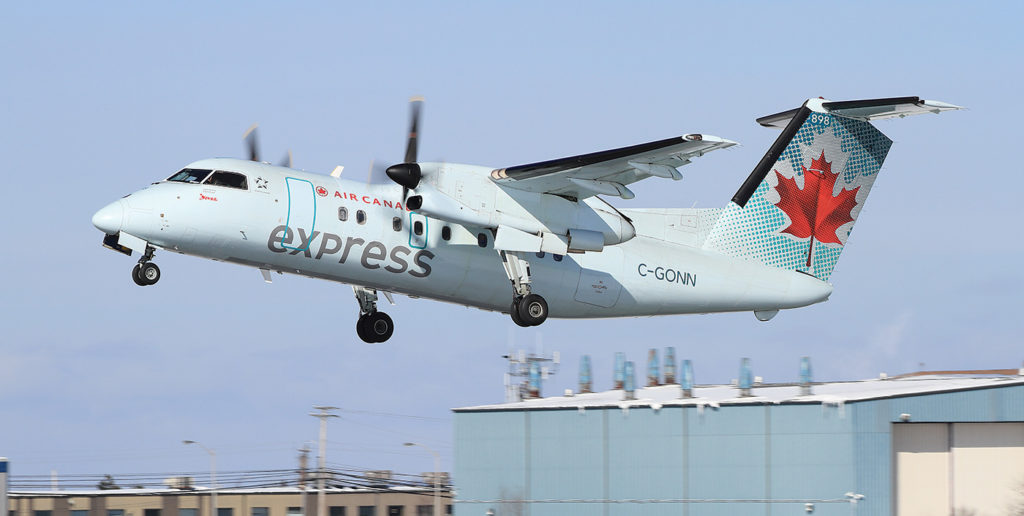
The NDP government in Ontario stepped forward to buy 49 per cent of DHC to protect the aerospace industry in Toronto and support the diversification of the company and the development of new aircraft.
To generate work, the Toronto plant was initially contracted to convert CL-215 waterbombers into CL-215T turboprops and paint new CRJ100s off the Montreal production line.
Later, Bombardier selected Toronto to assemble the long-range Global family of business jets and build the wings for the new Learjet 45, assembled in Wichita, Kan.
Bombardier Regional Aircraft Division
In 1992, the Bombardier Regional Aircraft Division (BRAD) was created to combine the airline sales, marketing and contracts teams for the Dash 8 and CRJ.
For the first 20 years, Bombardier’s sales, marketing and strategy team – responsible for the phenomenal sales success of the CRJ and Dash 8 – was based in Toronto, and later at international offices.
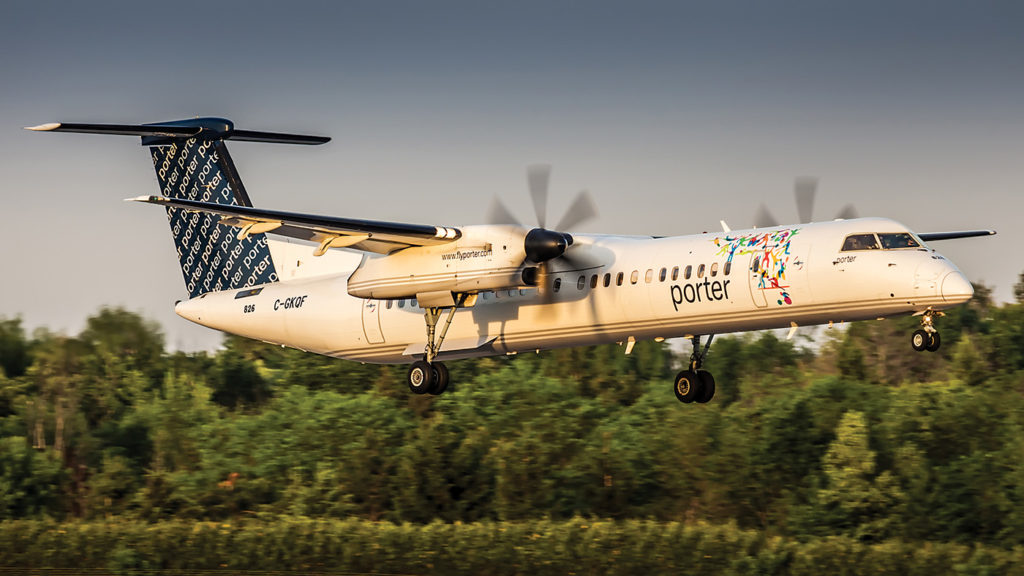
Montreal became the headquarters for the Bombardier Business Aircraft Division (BBAD), which led the marketing, completion and support of the Learjet and Challenger aircraft, as well as the ultra-long-range Global Express, announced at the 1991 National Business Aircraft Association convention.
BRAD and BBAD (later BCA and BBA) remained separate organizations optimized to sell different kinds of aircraft to very different kinds of customers, but both relied on Bombardier’s company-wide engineering and manufacturing organization.
CRJ enters service
The first 50-seat Bombardier CRJ100 aircraft was handed over to Lufthansa CityLine in October 1992. It entered revenue service between Frankfurt, Germany, and Barcelona, Spain, on Nov. 2, marking the dawn of an exciting new chapter in aviation history.
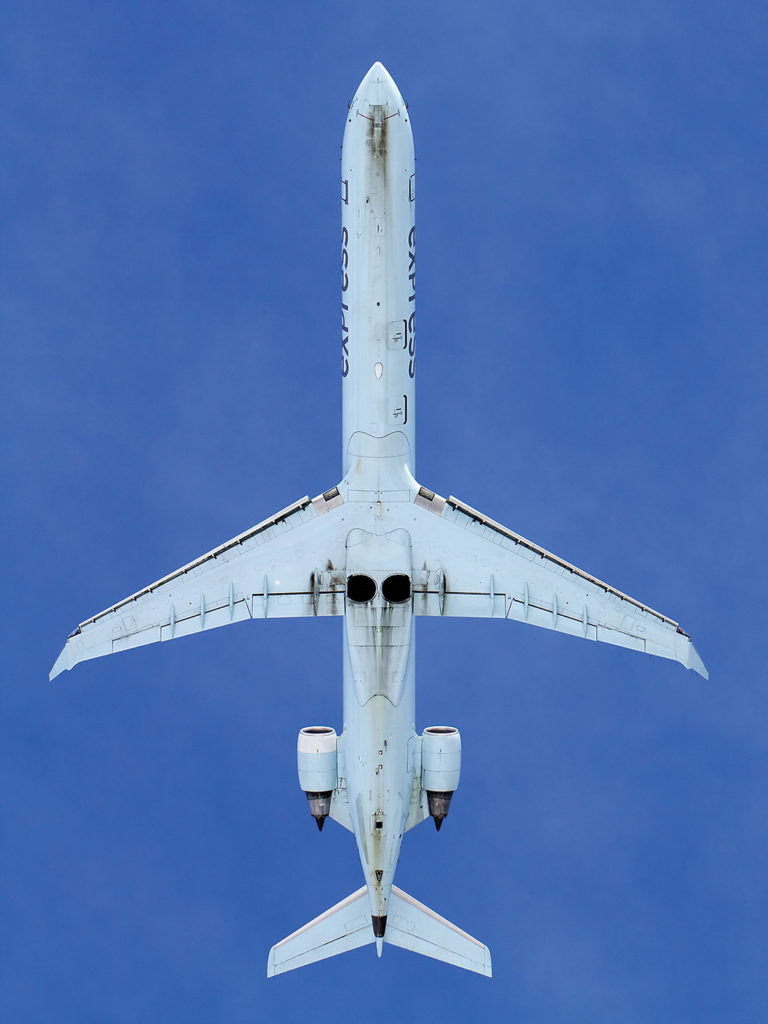
The first customers for the 50-seat CRJ in the United States were Comair Airlines and Skywest Airlines, two independent regional airlines that were part of the Delta Connection franchise. Air Canada purchased 50-seat CRJs to expand its U.S. trans-border network before “Open Skies” was implemented.
New regional aircraft families
The regional airline industry boomed in the 1990s as mainline airlines utilized smaller regional aircraft to expand hub and spoke networks.
Competition for this airline business was fierce, since there was a wide range of turboprops and regional jets to choose from, including models by Bombardier (Canadair, de Havilland and briefly Shorts), ATR, Beech, British Aerospace (BAE 146 and Jet Stream), CASA, Embraer, Dornier, Fairchild, Fokker, and SAAB. (In 2019, only Q400 owner Longview Aviation and ATR survive.)
Bombardier had a four-year head start with regional jets, but then Embraer entered the market when launch customer Express Jet (operating as Continental Express) took delivery of the first 50-seat ERJ-145 in late 1996. The new jet utilized the three-abreast fuselage cross section of the 30-seat EMB-120 Brasilia.
Bombardier’s product strategy was to develop complementary families of Dash 8 turboprops and CRJ regional jets and then let an airline decide which aircraft best suited their routes and passengers.
The company’s sales campaigns championed “right sizing” aircraft capacity to match passenger demand, in order to achieve high yields and profitability.
A total of 671 “classic” Bombardier Q Series Dash 8 aircraft (Q100/Series 100, Q200/Series 200 and (Q300/Series 300) were manufactured in Toronto between 1984 and 2009, after which production shifted exclusively to the popular Bombardier Q400.
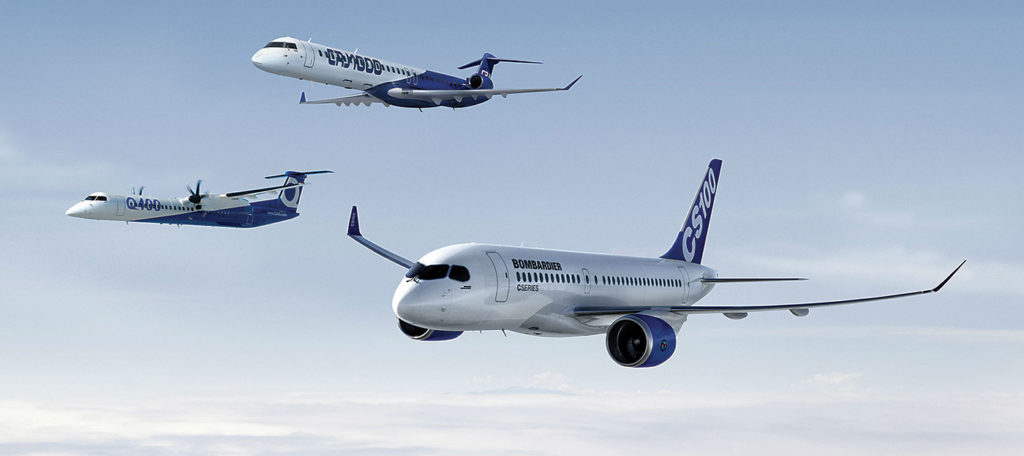
The Dash 8 was rebranded as the Bombardier Q Series Dash 8 family in 1998, following the successful incorporation of a noise and vibration suppression system to reduce cabin noise.
Development of the high speed, 70-seat Bombardier Dash 8 Q400 was announced at the Paris Air Show in June 1995. Its speed made the aircraft more productive from the airline viewpoint and allowed it to replace both turboprops and jets.
The Q400 was designed from the outset to have a low environmental footprint. This included low emissions, low fuel consumption (compared to similar capacity jets), and low noise levels inside and out.
Like the earlier Global business jet, Bombardier selected many international partners to participate in the Q400. The fuselage, tail and empennage were initially built by Mitsubishi Heavy Industries in Japan, and later transferred to Shenyang Aircraft (SAC) in China. Pratt & Whitney Canada of Quebec supplied the aircraft’s powerful 5,000-horsepower PW150 engines, Dowty Aerospace of England supplied the propellers, and Thales of France supplied the avionics.
The prototype Q400 rolled out on Nov. 22, 1997, and first flew at Toronto’s Downsview airport on Jan. 31, 1998.
CRJ700
Following the success of the 50-seat CRJ, Bombardier launched development of the 70-seat CRJ700 (originally CRJ-X) in 1997.
The CRJ700 (and later CRJ900) offered an improved passenger experience. The major interior changes included lowering the floor, raising the window position to improve visibility, and shifting the position of the overhead bins to increase carry-on baggage capacity.
The CRJ700 also brought a significant change to the aerodynamic design of the CRJ family, since it introduced leading edge devices – slats – to improve airfield performance. This allowed the larger and heavier CRJ700 to serve the same airports as the CRJ200 and under certain circumstances, even shorter runways.
The larger 100-seat CRJ1000 NextGen was launched in 2007 and was designed to provide regional airlines with more capacity and lower seat mile costs, particularly in the low-fare market. It was the first CRJ with a fly-by-wire rudder.
Both Dash 8 and CRJ families were designed to achieve common type rating/common crew qualification, which meant they could be flown by a common pool of pilots, increasing crew flexibility and lowering training costs.
Larger regional jets
Bombardier announced it was studying the design of a new 90- to 110-seat jet at the Farnborough Air Show in 1998.

The proposed BRJ-X would allow regional airlines to add a larger aircraft to accommodate traffic growth. The preliminary design concept was for an aircraft with an interior cabin width of 325 centimetres (128 inches) and a cabin height of 208.96 cm (82.27 ins), with three-plus-two seating. The maximum takeoff weight was expected to be about 40,825 kilograms (90,000 pounds), requiring engines in the 20,000 pounds of thrust class.
That’s when P&WC launched the advanced technology fan integrator (ATFI) project to help develop a 10,000 to 20,000 pound thrust geared-fan engine suitable for Bombardier’s proposed BRJ-X regional airliner.
But the feedback Bombardier received from airlines was that they wanted a “simple stretch” of the CRJ that could be operated by scope-restricted airlines (with 76 seats), rather than a completely new design.
The BRJ-X was shelved in 2000, but Pratt & Whitney continued work on its geared-fan concept.
Other aircraft manufacturers moved forward with plans to develop larger regional jets, while Bombardier hesitated.
Fairchild Dornier launched a new family of regional jets in 1998 (528JET, 728JET and 928JET) in the 55- to 100-seat range powered by GE CF34s. (It folded in 2002 before the first 728JET flew.)
And in 1999, Embraer leapfrogged the CRJ family by launching the CF-34 powered E-Jet family.
New Mirabel facility
The CRJ700 also introduced a new level of international collaboration. The wing, forward fuselage, rudder and flight surfaces were designed and are currently produced by Bombardier in Montreal, while the mid-fuselage was designed and is produced by Bombardier’s Belfast factory in Northern Ireland.
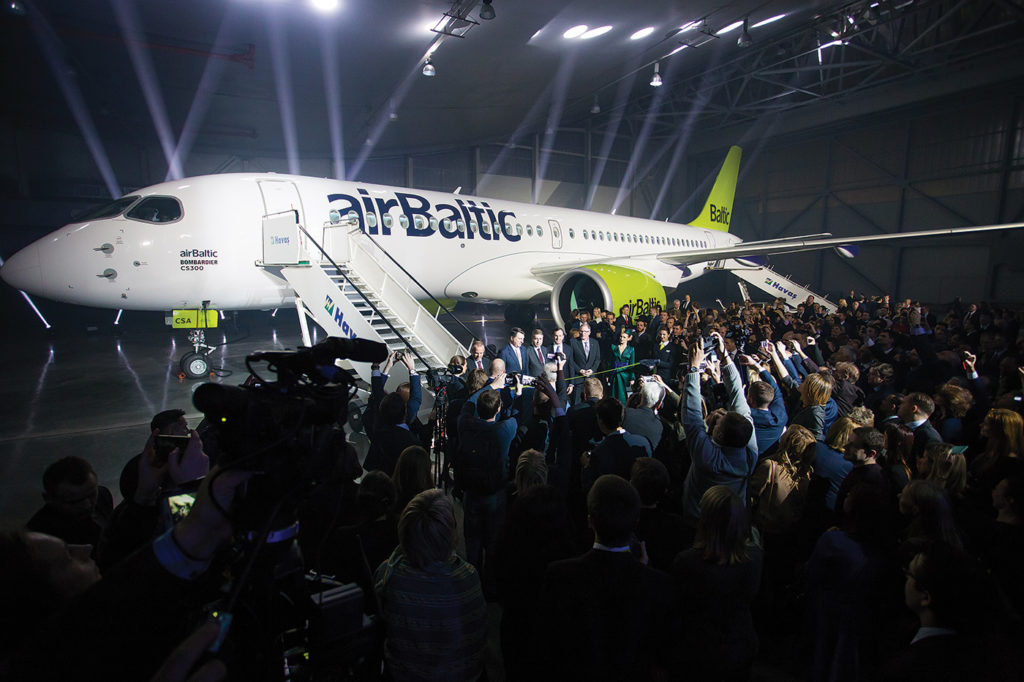
Not long after CRJ700 production began, the final assembly was moved to a new $170 million CRJ700/CRJ900 plant at Mirabel Airport north of Montreal, which officially opened on Oct. 22, 2001.
The opening of the new facility was marred by the Sept. 11 terrorist attacks, which sent the industry into a tailspin. Layoff notices were issued to thousands of Bombardier employees and the company’s share price collapsed from a record high in the summer.
Shifting regional demand
Bombardier delivered the 1,000th CRJ regional jet in December 2003 – a 70-seat CRJ700 for Delta Connection carrier Comair – and the next year delivered 232 regional aircraft (214 CRJs and 18 Q300/Q400 Dash 8s), along with 89 business aircraft (41 Learjets, 31 Challengers and 17 Globals).
The CRJ NextGen was introduced in 2008 and the Q400 NextGen in 2009. Upgrades improved the passenger experience (e.g. new interior, more natural light, bright LED lighting and larger overhead bins), and reduced operating costs (e.g. lower fuel burn, lower maintenance costs).
By the late 2000s, rising fuel prices slashed demand for smaller regional aircraft.
The last CRJ200 airline delivery came in 2007 and the final 37- and 50-seat Dash 8 deliveries in 2009. (The last CRJ200 built was in fact a Challenger 850 business jet delivered in 2012.)
However, high fuel prices stimulated demand for larger members of the CRJ family and especially for turboprops, with Q400 deliveries increasing from nine aircraft in 2003 to 56 aircraft in both 2011 and 2012. These conditions led to a “turboprop renaissance,” which saw turboprops replace uneconomical regional jets.
C Series
During the early 2000s, Bombardier understood that airlines wanted a new generation aircraft with lower seat mile costs that could generate higher profits.
The manufacturer challenged leading engine makers – CFM International (CFM56), International Aero Engines (V2500) and Pratt & Whitney (PW6000) – to develop a new centreline engine with a 15 per cent operating cost benefit over current designs.
At the 2006 Paris Air Show, Bombardier announced plans for its new C Series passenger jet with the “game changing” Pratt & Whitney geared turbofan (GTF) as its engine choice.
When the Montreal-based OEM officially launched the C Series program at the Farnborough Air Show in 2008, powered by a pair of Pratt & Whitney PurePower PW1000 series GTF engines, world oil prices had reached a record US$147 a barrel!
Pratt & Whitney’s ultra-high-efficiency GTF was going to be a real differentiator for the C Series, since the state-of-the-art gear system allowed the engine’s fan to operate at a different speed than the low-pressure compressor and turbine, thereby delivering double digit reductions in fuel burn, carbon dioxide and nitrogen oxide emissions, engine noise and operating costs.
However, P&W did a good selling job and the GTF was selected to re-engine in-production aircraft, including the Airbus A320Neo and the Embraer E-Jet E2, and chosen to power Mitsubishi’s clean-sheet MRJ regional jet.
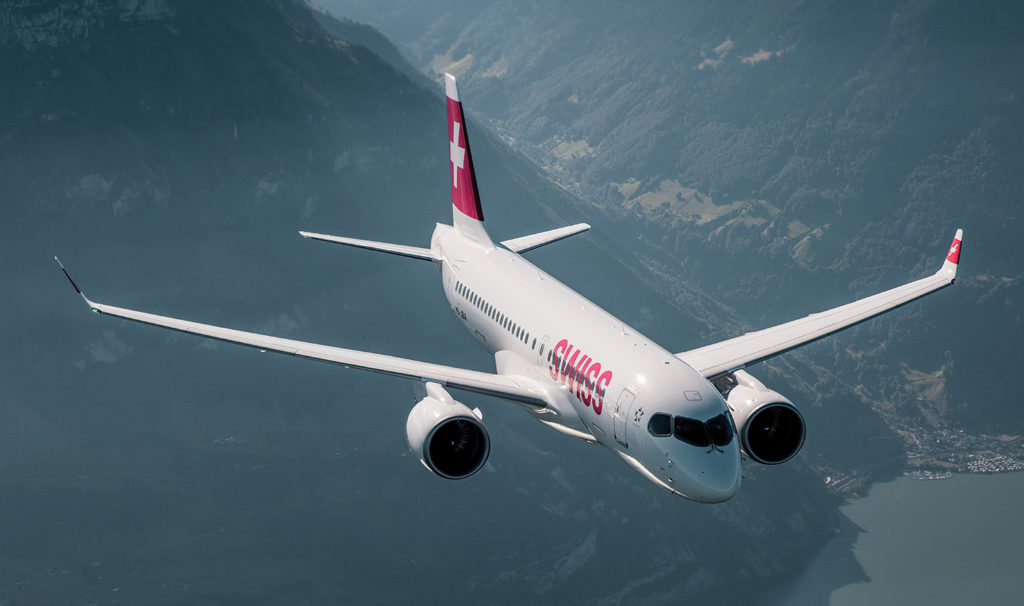
Order book
In March 2009, Bombardier announced that Deutsche Lufthansa AG, the launch customer for the C Series, had signed a firm purchase agreement for 30 CS100 aircraft to be operated by its subsidiary, Swiss International Air Lines (Swiss), with the aircraft originally expected to enter service in 2013.
Korean Air ordered 10 CS300s in 2011 and airBaltic ordered 10 CS300s in 2012, with most firm orders from smaller and lesser known airlines.
However, other large and experienced airlines were reluctant to place a launch customer order for a new aircraft with a new engine.
At the same time, the Boeing and Airbus duopoly also worked very hard to deter their customers from ordering the C Series, which they saw as a serious competitor, until they were forced to introduce new generation engines on the B737 and A320.
Turbulence
Developing a new clean sheet commercial aircraft is not for the faint of heart.
It is often regarded as an aggressive “bet the company” product strategy that aims to be first-to-market with a new generation aircraft offering significant operating cost savings together with enhanced performance capabilities.
Insiders say Bombardier was not naïve about the challenge of developing the C Series and tried to mitigate every risk they identified; but in hindsight, Bombardier did not have the depth of aircraft experience to develop and integrate a brand-new aircraft with lots of leading-edge technology made by partners.
Many costly delays were incurred during development, resulting in the C Series entering commercial service two-and-a-half years behind schedule and more than US$2 billion over budget, during which time Bombardier also racked up more than $9 billion in debt.
Not all the challenges came from the C Series program. Development of the all-composite Learjet 85 was cancelled in October 2015, as the company reported an overall $4.9 billion loss in the third quarter of that year and then announced a $1 billion cash bailout from the Quebec government, which would see the province assume a 49.5 per cent stake in the C Series program.
Leadership
The desperate need to find new customers for the C Series diverted efforts from selling the Q400 and CRJ700/900/1000, while precluding investments in new product improvements.
This helped Embraer capture the majority of the regional jet market with the E-Jet, while ATR secured more than three-quarters of the global turboprop market.
One of the internal challenges was that several executives that were dropped into the leadership teams of Bombardier Aerospace and Bombardier Commercial Aircraft had little or no background in aviation or the airline industry, which made it hard to sell the C Series during this critical period.
In addition, the lack of leadership meant the commercial aircraft division lost many very talented people to business aircraft, competitors and other industries. For example, when Bombardier Aerospace was formed, there was a real effort to establish executive offices in Montreal and Toronto to retain experienced employees and tap the best talent in French- and English-speaking Canada.
Former executives have observed that Bombardier subsequently developed the habit of hiring executives from outside the company and Canada to lead its aviation businesses, rather than promoting talent from within.
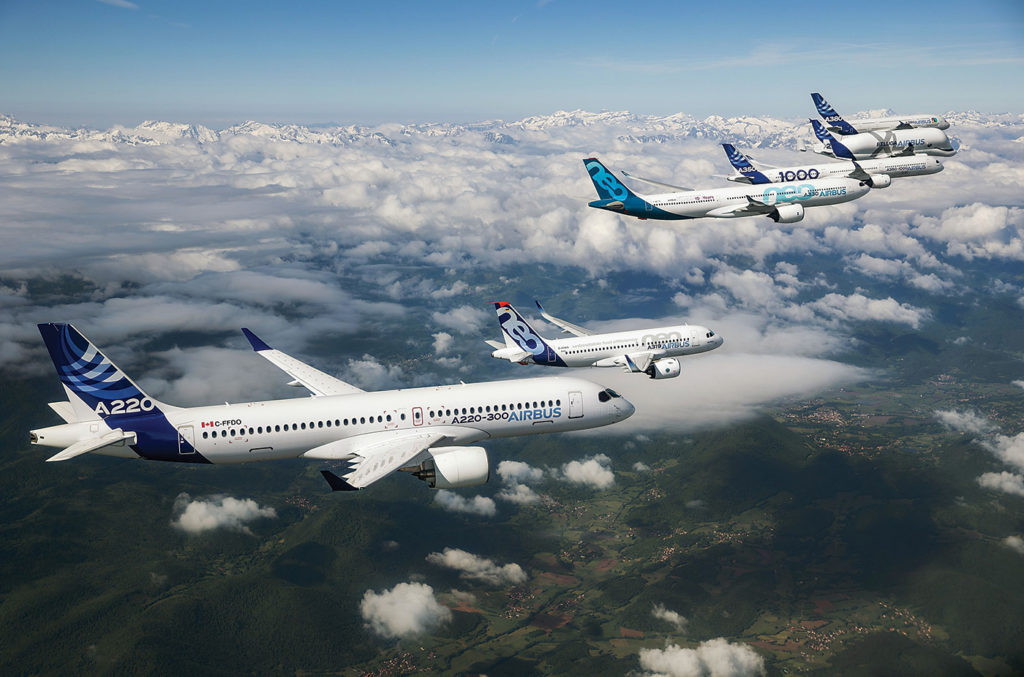
Recovery
Bombardier recognized a few years ago that drastic steps were required to survive as a company.
First, it had to win a strategic customer for the C Series in North America – the world’s largest air transport market – so the entire airline industry would wake up and take notice.
All aircraft manufacturers, including Airbus and Boeing, offer launch customer pricing for a new aircraft program, but the large North American customers held back on the C Series until Delta Air Lines ordered aircraft in April 2016. Boeing latched onto the Delta sale to mount a campaign in Washington that called for punitive import tariffs to be levied on every C Series delivered to the U.S. airline.
The play ultimately backfired, because it forced Bombardier to sell the C Series to archrival Airbus, which subsequently launched plans to build the CS100 (now the A220-100) and the CS300 (now the A220-300) at its new U.S. aircraft factory in Mobile, Ala.
That is great news for the C Series program, but Bombardier is still on the hook to fund many aspects of that aircraft program, as well as to service its corporate debt.
The asset sales began in January 2015, when Bombardier announced it had sold its military aviation training division to Montreal-based simulator giant CAE for $19.8 million.
Then, in June 2016, its legacy CL-215/415 amphibian business was sold to British Columbia-based Viking Air Limited for an undisclosed price.
In May 2018, the company’s Downsview, Ont., manufacturing site was sold to the Public Sector Pension Investment Board for $817 million.
Shortly afterwards, Bombardier moved to divest itself of its commercial aircraft programs, as outlined at the beginning of this article.
While the roller-coaster ride that was Bombardier Commercial Aircraft has reached the end of the track, there’s no doubt its products have made an indelible mark on global aviation. Hopefully they will continue to do so – albeit in the hands of a new group of talented aerospace companies.


Thanks Mr Swartz, I worked 26 years at Bombardier in Montréal from 1992 until 2018 and I can say you’ve not skipped one detail, truly reading your story stirred lots of memories. It’s so sad for all the highly skilled employees who worked so hard while the inexperienced people in management kept on making one bad decision after another day in, day out.
This article ignores the effects of the Challenger and (failed) Learjet programs which ran in parallel with the c-series.
I am so very proud to have played but a small part in the life of these programs during my entire working life in aerospace … So very sad to see yet another era of Canadian Aerospace fall to the misfortunes of Political Global Greed and Senior Mismanagement … When will Canada ever learn … Choose your friends carefully.
What if the CRJ-1000 in a two seat per row configuration was the best solution post-Covid for regional transport? It could be another chapter of the story…
The icing on the cake is the severance package (17.5 million) afforded to a CEO who allowed the company to do a uncontrolled nose dive into terrain, what a shame. Canadians should not be once again be asked to extend a hand to the drowing victim. Enough is enough.